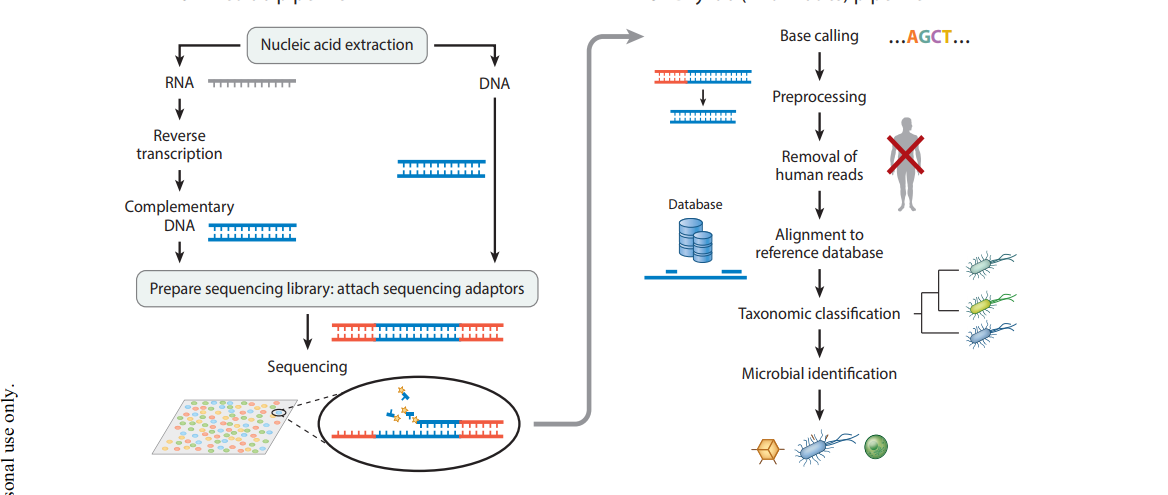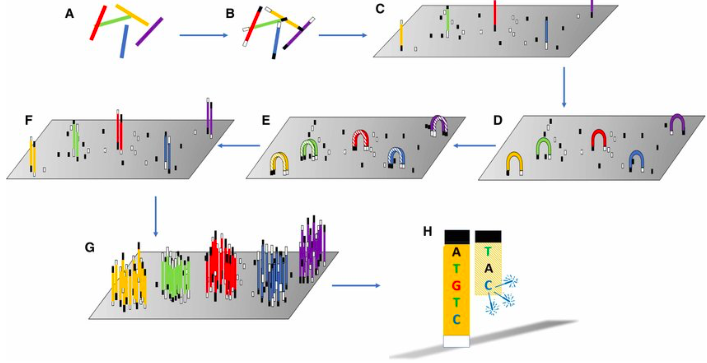Sequencing became one of the revolutionary tools in molecular biology and biomedicine that allowed a better understanding of the genomes of various organisms. The first method that became foundational for the next-generation sequencing systems was Sanger’s dideoxy synthesis, developed in 1977 (Slatko et al., 2018). It is a complex process that involves genome extraction, reverse transcription, creation of complementary DNA, sequencing, and bioinformatic analysis (Figure 1). All next-generation sequencing systems are capable of running millions of reactions simultaneously, while Sanger’s method could only produce one sequence per reaction (Kumar et al., 2019). Second-generation sequencing is the variety of techniques such as pyrosequencing and Illumina that utilize short oligonucleotide sequences, while third-generation sequencing is known as one molecule long fragments sequencing.

Second-generation sequencing was the next step in the evolution of this tool that could analyze longer oligonucleotide sequences. It can be subdivided into two major types of sequencing by synthesis and hybridization (Slatko et al., 2018). The latter utilized known oligonucleotide sequences to hybridize them to the unknown sequence, while the former implemented amplification with polymerase chain reaction (PCR) and then sequencing (Slatko et al., 2018). The current leader on this market, Illumina, developed by Lynx and Solexa Therapeutics, uses sequencing by synthesis to analyze genomes (Slatko et al., 2018). The central principle of this method is “bridge amplification,” which means that a single molecule of DNA is attached to the primer sequence on a glass slide and then amplified through in situ PCR (Slatko et al., 2018). Nucleotides labeled with a specific fluorescent dye are introduced in each reaction for its termination and detection (Figure 2). Older versions of this platform used four different fluorescent tags while new protocols implemented two or one dye (Kumar et al., 2019). After completing this process, multiple clusters of oligonucleotide sequences are generated for analysis.

Illumina and Ion Torrent are the leading sequencing companies because they offer accuracy and speed for a relatively low price. Depending on the genome length, it may take from 7 to 56 hours of sequencing (Kumar et al., 2019). Notably, Illumina “supports a variety of protocols including genomic sequencing, exome, and targeted sequencing, metagenomics, RNA sequencing, CHIP-seq, and methylome methods” (Slatko et al., 2018, pp. 4-5). Furthermore, the cost per genome sequencing has been reduced to less than $1000 (Kumar et al., 2019). Still, the possibility of random errors exists at various Illumina instruments. Ion Torrent applies a semi-conductor sequencing technique that relies on pH changes caused by the release of hydrogen ions amid the polymerization reaction (Pereira et al., 2020). These changes are converted to electric signals and recorded as base readings. Unfortunately, although it allows for accurate identification of oligonucleotides, the Ion Torrent method is not practical for large sequences.
Third-generation sequencing systems are known for their real-time data analysis and the ability to sequence long oligonucleotide sequences without fragmenting them into small pieces. This approach allowed to overcome the issue of errors of reading repetitive sequences (Kumar et al., 2019). Moreover, it improved the accuracy because fewer and longer fragments of genomes were analyzed. The first third-generation technique was single-molecule real-time (SMRT) sequencing invented by Pacific Biosciences (PacBio), which utilizes two primary methodologies, RSII and Sequel (Slatko et al., 2018). DNA is placed at the bottom of a specific chamber where the complementary sequence is synthesized using fluorescently labeled oligonucleotides that emit light and are detected by a powerful microscope (Slatko et al., 2018). One PacBio chip is capable of holding millions of reactions simultaneously. The analysis of long sequences was enabled because fluorescent tags are removed after each nucleotide is added to continue the reaction (Kumar et al., 2019). Although the inaccuracy rate is still high in this system, these errors are random, producing an overall correct result. SMRT is the perfect tool for evaluating long genomic sequences and determining epigenetic changes.
In summary, the second and third-generation sequencing systems were designed to increase the amount of genome that can be covered and improve the accuracy of oligonucleotide detection. The whole sequencing process starts from genome isolation from a cell, followed by reverse transcription, amplification, sequencing, and analysis. The second-generation systems are dominated by Illumina’s sequencing by synthesizing four, two, or one fluorescent dye to detect specific nucleotides. Another competitor of this company is Ion Torrent that identifies oligonucleotides through pH alterations during the polymerase reaction. This approach is also accurate, but it is impractical for large genomes; thus, Illumina is preferred in research. Illumina’s approach is to evaluate short oligonucleotide sequences to build a larger picture. On the other hand, third-generation systems use techniques for analyzing long genomic sequences. Overall, next-generation sequencing methods allowed to make this process faster and more widely available to researchers worldwide.
References
Court, D. (2021). Mitochondrial DNA in forensic use. Emerging Topics in Life Sciences, 5, 1-12. Web.
Gu, W., Miller, S., & Chiu, C. Y. (2019). Clinical metagenomic next-generation sequencing for pathogen detection. Annual Review of Pathology: Mechanisms of Disease, 14, 319-338. Web.
Kumar, K. R., Cowley, M. J., & Davis, R. L. (2019). Next-generation sequencing and emerging technologies. Seminars in Thrombosis and Hemostasis, 45(7), 661-673.
Pereira, R., Oliveira, J., & Sousa, M. (2020). Bioinformatics and computational tools for next-generation sequencing analysis in clinical genetics. Journal of Clinical Medicine, 9(1), 1-30. Web.
Slatko, B. E., Gardner, A. F., & Ausubel, F. M. (2018). Overview of next‐generation sequencing technologies. Current Protocols in Molecular Biology, 122(1), 1-11. Web.